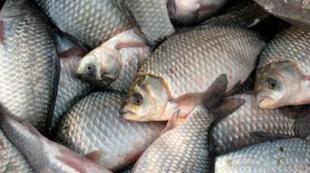For everyone and about everything. Order Lepidoptera (butterflies)
These creatures are incredible - they are so beautiful in their delicate fragility and brightness that they were sung by poets, they were painted by numerous artists, they were admired at all times. Let's look at this splendor of colors, variety of forms and revere Interesting Facts about butterflies...
Butterflies belong to one of the largest groups of insects - Lepidoptera.
And what about North Korea? This is the famous painting "Soldier's Selfless Love" given to Kim In Sen and made by soldiers of his army from the wings of 4.5 million butterflies...
165 thousand species of butterflies are known. But almost every year, entomologists discover a new species.
Lepidopterology is the name of the science of butterflies.
Attakus Atlas is the largest night moth that can be mistaken for a bird, because. its wingspan is 30 cm.
The smallest butterfly is the moth from England (Acetozei) and the moth, whose homeland is the Canary Islands (Rediculosis). The body length of these butterflies is only 2 mm. The wingspan is also 2 mm.
Females live longer than males.
The weight of a butterfly is equal to the weight of two rose petals.
Butterflies do not hear, but they recognize predators and other dangers by vibrations.
In China, India, South America, butterflies are a delicious treat.
The only continent on the planet where butterflies have not been found is Antarctica.
Calyptra eustrigata are predators among butterflies, they drink the blood of animals, which they get by piercing the covers of animals with a sharp proboscis. Only males are predators.
Caterpillars of the "small monarch" (Danaus cbrysippus) feed on the juice of herbs that release toxic substances. Later, the butterfly that emerged from the chrysalis is poisonous; a bird that swallows such a butterfly may die.
The Brazilian caligo butterfly defends itself in this way - at the sight of a bird, it turns over, showing a pattern on inside wings - the pattern exactly repeats the face of an owl with bright eyes and a sharp beak. This scares off predators.
Male butterflies (Pieris napi) smell like lemon flowers.
Butterflies can consume food 2 times their own weight.
Caterpillar of the corn or stem borer (Ostrinia nubilalis) withstands temperatures down to -80’C
There are butterflies that do not feed at all due to the lack of a proboscis - they live off the energy that they accumulated while still being caterpillars
Some butterflies in the tropics feed exclusively on animal tears.
The meadow moth (Loxostege sticticalis) weighs about 0.025 g. By the end of summer, its offspring (caterpillars) weigh 225 kilograms. During the period of their development, they eat up to 9 tons of green mass, i.e. as much as three cows eat in a year.
Butterfly Red Admiral (and some other species) feed on manure and rotting fruit
Butterflies can drink the juice of rotting fruit and be in a state of intoxication with all its signs - disorientation, tangled legs and wings that do not fly ...
The taste buds of the bales are on their feet, so in order to recognize the food, the butterfly needs to stand on it.
Butterflies do not have a heart, veins and arteries - all this is replaced by a special tube that runs from the abdomen to the head
This is how monarch butterflies migrate - millions of "flocks"
butterfly wings
Butterfly chrysalis
From chrysalis to butterfly
The structure of the butterfly's eye is a complex system of 6000 lenses
Butterflies are able to distinguish between yellow, green and red.
A female butterfly lays 1,000 eggs in her lifetime.
Butterfly skeleton - exoskeleton - outside of the body
Butterflies cannot fly during an earthquake
One of the most voracious creatures in the world - caterpillars of the Saturnian butterfly Polyphemus (Antheraea polyphemus) - barely born, the caterpillar eats foliage 86 thousand times its own weight
Hawk hawks can reach speeds of up to 60 km / h and cover in a minute a distance that is 25-30 thousand times larger than their body
Lilac moth (Naxa seriaria) - easily takes off from any surface, even pulled under water, it emerges and takes off directly from the surface
Butterfly belongs to the class Insects, phylum Arthropoda, order Lepidoptera (Lepidóptera).
The Russian name "butterfly" comes from the Old Slavonic word "babаka", denoting the concept of "old woman" or "grandmother". In the beliefs of the ancient Slavs, it was believed that these were the souls of the dead, so people treated them with respect.
Butterfly: description and photo. The structure and appearance of butterflies
In the structure of a butterfly, two main sections are distinguished - a body protected by a hard chitinous shell and wings.
A butterfly is an insect whose body consists of:
- Head, inactively connected to the chest. The head of a butterfly has a rounded shape with a slightly flattened occiput. Round or oval convex eyes of a butterfly in the form of hemispheres, occupying most of the lateral surface of the head, have a complex facet structure. Butterflies have color vision, and moving objects perceive better than stationary ones. Many species have additional simple parietal eyes behind the antennae. The structure of the oral apparatus depends on the species and can be of a sucking or gnawing type.

- Breast having a three-segment structure. The front part is much smaller than the middle and back, where there are three pairs of legs, which have a structure characteristic of insects. On the shins of the front legs of the butterfly there are spurs designed to maintain the hygiene of the antennae.
- The abdomen has the shape of an elongated cylinder, consisting of ten ring-shaped segments with spiracles located on them.

Butterfly structure
The antennae of a butterfly are located on the border of the parietal and frontal parts of the head. They help butterflies to navigate in the environment, perceiving air vibrations and various smells.
The length and structure of the antennae depend on the species.


Two pairs of butterfly wings, covered with flat scales of various shapes, have a membranous structure and are pierced by transverse and longitudinal veins. The size of the hind wings can be the same as the front wings or much smaller than them. The pattern of butterfly wings varies from species to species and captivates with its beauty.
When macro photography, the scales on the wings of butterflies are very clearly visible - they can have completely different shape and color.

Butterfly wings - macro photography

The appearance and coloration of the butterfly's wings serve not only for intraspecific sexual recognition, but also act as a protective camouflage that allows you to blend in with your surroundings. Therefore, colors can be both monochrome and variegated with a complex pattern.
The size of a butterfly, or better to say the wingspan of a butterfly, can range from 2 mm to 31 cm.

Classification and types of butterflies
The numerous detachment of Lepidoptera includes more than 158 thousand representatives. There are several classification systems for butterflies, quite complex and intricate, with changes constantly taking place in them. The most successful is the scheme that divides this detachment into four suborders:
1) Primary toothed moths. These are small butterflies with a wingspan ranging from 4 to 15 mm, with gnawing mouthparts and antennae that reach up to 75% of the size of the forewings in length. The family consists of 160 species of butterflies.
Typical representatives are:
- golden winged ( Micropteryx calthella);
- marigold smallwing ( Micropteryx calthella).

2) Proboscis butterflies. The wingspan of these insects, covered with dark small scales with cream or black spots, does not exceed 25 mm. Until 1967, they were classified as primary toothed moths, with which this family has much in common.
The most famous butterflies from this suborder:
- flour fire ( Asopia farinalis L..),
- fir cone moth ( Dioryctrica abieteila).

3) Heterobatmia, represented by one family Heterobathmiidae.
4) Proboscis butterflies, which make up the most numerous suborder, consisting of several dozen families, which include more than 150 thousand species of butterflies. Appearance and the sizes of representatives of this suborder are very diverse. Below are several families that demonstrate the diversity of proboscis butterflies.
- Sailboat family, represented by medium and large butterflies with a wingspan of 50 to 280 mm. The pattern on the wings of butterflies consists of black, red or blue spots of various shapes, clearly visible on a white or yellow background. The most famous of them are:
- Butterfly swallowtail;
- Sailboat "Glory of Bhutan";
- Birdwing of Queen Alexandra and others.

Butterfly swallowtail


- Nymphalidae family, feature which is the absence of thickened veins on wide angular wings with variegated coloration and various patterns. Butterfly wingspan varies from 50 to 130 mm. Representatives of this family are:
- Butterfly admiral;
- Butterfly diurnal peacock eye;
- Butterfly urticaria;
- Butterfly mourning, etc.

Butterfly Admiral (Vanessa atalanta)

Butterfly diurnal peacock eye

Butterfly urticaria (Aglais urticae)

Butterfly mourner
- , represented by night butterflies with narrow wings, the span of which does not exceed 13 cm and is distinguished by a characteristic pattern. The abdomen of these insects is thickened and spindle-shaped. The most famous butterflies of this family:
- Hawk hawk "dead head";
- Oleander hawk;
- Poplar hawk.



- Owl family, which includes more than 35,000 species of night butterflies. The span of gray with a metallic shade of fluffy wings averages 35 mm. However, in South America there is a species of butterflies tizania agrippina with a wingspan of 31 cm or atlas peacock-eye, the size of which resembles a medium-sized bird.


Where do butterflies live in nature?
The distribution range of butterflies on the planet is very wide. It does not include only the ice expanses of Antarctica. Butterflies live everywhere from North America and Greenland to the coast of Australia and the island of Tasmania. The largest number of species was found in Peru and India. These fluttering insects make their flights not only in the flowering valleys, but also high in the mountains.
What do butterflies eat?
The diet of many butterflies consists of pollen and nectar. flowering plants. Many species of butterflies feed on tree sap, overripe and rotting fruit. And the dead head hawk moth is a real gourmet, because it often flies into hives and regales itself on the honey they have collected.

Some Nymphalidae butterflies need various trace elements and additional moisture. Their source is excrement, urine and sweat of large animals, wet clay, and human sweat.
.These butterflies include the Madagascar comet, whose wingspan is 14-16 cm. The life expectancy of this butterfly is 2-3 days.

Also among the butterflies there are "vampires". For example, males of some species of cutworms maintain their strength thanks to the blood and tear fluid of animals.
Such is the vampire butterfly (lat. Calyptra).

- The wings are painted so unusually that it cannot be confused with any other butterfly in the world. Outwardly, the male and female are very similar to each other.
The range of the daytime peacock eye covers all of Europe (except for the northernmost regions) and temperate latitudes of Asia.
Butterflies hibernate in basements, attics, in caves... Overwintered individuals fly in March - May, and a new generation appears in July - August.
The butterfly got its name because of the bizarre spots in the lower corner of the wings, which are similar to the shape of the eye. In general, the color of the Peacock's eye varies from bright red to deep brown. All this is artistically diluted in black with beautiful patterns and stripes.
There is also a nocturnal Peacock eye, which differs from its congener in darker colors and brown spots. Its outstretched wings reach up to 15 centimeters in length. At night, the Peacock Eye is very reminiscent of bat than a butterfly.

Apollo
Daytime butterfly, listed in the Red Book. There is a butterfly in the Urals, in Siberia and the mountains of the Caucasus. One of the reasons for this choice of terrain is nutritional habits, Apollo prefers thickets of stonecrop and hare cabbage, which are found mainly in mountainous areas.
The butterfly has a bright beautiful color, it is clearly visible in the open area. Apollo is easily recognizable by its large wings with black and red spots. Depending on the location of the spots, more than 600 forms of this species are distinguished.
Butterflies can be found from June to August. Apollo flies slowly, imposingly, often gets tired, sits on flowers.
Apollo is a real "sissy", a butterfly needs good conditions external environment in order to survive. Bright sun and plenty of food are among the most necessary.

Admiral
Adults of the white admiral have black wings with white stripes. This contrast of colors helps to sort of "break" the wing line, thereby camouflaging the butterfly from predators. Their wingspan is approximately 60-65 millimeters. The flight is very interesting, elegant, consisting of short periods of flapping followed by a long hover.

Red Admiral. This is a well-known brightly colored butterfly. This species constantly lives in warmer places, but migrates north in spring, and sometimes back in autumn. This large butterfly is easily recognizable by its bright dark brown with red and black wing pattern. Caterpillars feed on nettle leaves, adults drink nectar from the flowers of plants such as buddleia (which is also called butterfly bush because of this) and can feast on overripe fruits.
In northern Europe, it is one of the last butterflies to be seen before the onset of winter: it appears near a faint fire and feeds on the nectar of autumn flowers on warm days. The red admiral is also known for the fact that when he overwinter, he becomes darker in color than individuals who have not yet survived the winter. The butterfly can also fly out on sunny winter days, for the most part this applies to southern Europe.

mourning house
For many people, their first childhood impressions of butterflies were formed when they met a large, spectacular, memorable mourning place. And for some future entomologists, these impressions turned out to be so strong that they determined the subsequent choice of profession.
With the predominance of dark color on the wings of the mourning woman, her names are also associated in other languages. So. Americans call her mourning cloak "mourning robe", and the French - deuil - "mourning", "sorrow". Perhaps this was also taken into account by K. Linnaeus, who in 1758 named the butterfly antiopa - after the daughter of the Theban king Niktey, who, even by the standards of ancient Greek myths, had to endure many troubles and suffering.
“Dark coffee, shiny, lacquered, its wings seem velvety in abundance of colored dust, and to the very abdomen or torso they seem to be covered with moss or thin reddish hairs. The edges of the wings, both upper and lower, are trimmed with a pale yellow, fawn, rather wide jagged border, carved with scallops ... and along the fawn border, on both wings, bright blue spots are placed ... "S. T. Aksakov

Hives
The specific epithet of the scientific name, urticae, comes from the word urtica (nettle) and is explained by the fact that nettle is one of the fodder plants of caterpillars of this species.
Males differ little from females in coloration. Wings are brick-red dorsally, with a number of large black spots separated by yellow gaps near the costal margin; at the top of the forewing a small White spot. The basal half of the hind wing is brown-brown, the outer half is brick-red; there is a sharp border between these areas. On the outer edge of the wings there is a row of blue crescent-shaped spots. The lower surface of the wings is brownish-brown, a wide yellowish stripe runs across the front wing.
It is found everywhere in Russia, except for the Far North.

mother-of-pearl
Large mother-of-pearls from the genus Argynnis often fly together and are clearly distinguishable mainly on the underside of the hindwings. Males of large forest mother-of-pearl (A. paphia) with blackouts along the longitudinal veins on the front wings, females are red or greenish-gray above. The bottom of the hind wings of this species has transverse light bands. Mother-of-pearl aglaya (A. aglaja) from below with bright silvery spots, in mother-of-pearl adippa (A. adippe) these spots are dimmer, and there are a number of eyes along the edge. All these species develop on violets.
A large and beautiful mother-of-pearl daphne (Neobrenthis daphne) is rare in the Baikal region and is listed in the Red Book, but a close view of the meadowsweet mother-of-pearl (N. ino) is very commonplace in meadows and glades
Forest mother-of-pearl (male) 
golubyanki
A very large family, including butterflies of small size (wingspan 27-28 mm), many of which have a shiny, metallic color. hallmark pigeons are shortened front legs. Most European pigeons are blue, although males are often brown. Among the pigeons, there are those in which the posterior pair of wings has characteristic outgrowths ("tails"), for which they are called "tails". The family also includes chervonets, bright orange on top. In Russia, there are several hundred species of pigeons from more than fifty genera. Doves fly through meadows, forest edges and clearings. Caterpillars feed on the leaves of trees, shrubs, and herbaceous plants. Caterpillars of some species pupate in anthills.
Golubyanka Icarus 
Golubyanka forest or Poluargus 
Belyanki
A family of diurnal butterflies with predominantly white wings and a pattern of yellow, orange and black spots and fields, club-shaped bands, rounded triangular forewings and ovoid hindwings.
Cabbage butterfly 
Swallowtail
The great naturalist Carl Linnaeus named this butterfly in honor of the mythical hero of the Trojan War, the famous doctor Machaon, who alleviated suffering and saved the lives of many wounded soldiers.
Machaon is found throughout the country, with the exception of the Far North.
On the bright yellow wings of the swallowtail, blackened veins and a wide black border with a wavy inner and jagged outer edges stand out. A band of blue sputtering runs along the border, especially bright on the hind wing, and along the outer edge there is a band of yellow spots-holes. The root region of the forewing is black with a yellow coating. The hind wing is decorated with a bright red rounded spot and a black tail.
The caterpillar is not picky in food: it feeds on plants of the families Umbelliferae, rue, Compositae and Lamiaceae. Swallowtail hibernates in the pupal stage.
In most of its range, the swallowtail gives two generations a year, and only in its northernmost regions - one. Butterflies of the first generation fly in May - June, and the second - in July - August.

Sericin montela
Sericin montela is one of the amazing Ussuri relics. The butterfly has been preserved here since ancient times, since the territory of Primorsky Krai has never been subjected to complete glaciation; is rare. The background color of the female's wings is dark brown. Its front wing is crossed by thin dark yellow and ocher yellow bands of various lengths. The flight of these butterflies is very slow, even sluggish. They always stick to thickets of caterpillar food plant - kirkazon, growing in some places along the banks of rivers, streams and at the foot of hills.

The wings of the male are white. The pattern of the forewing consists of black, mostly elongated spots, as well as darkening along the edge of its apex. The rear wing is decorated spectacularly. At its front edge, a red elongated spot in a black frame usually stands out. At the back corner there is a bright red short bandage, to outside which are adjacent blue spots in a black frame. The hind wing is completed by a long thin brown-brown tail.

tailed maak
This largest diurnal butterfly in Russia surpasses many tropical relatives in its beauty. It is hard to believe that the distribution area of this wonderful sailboat extends to 54 ° north latitude, where Tynda and the north of Sakhalin are located.
The female is larger than the male, its wingspan reaches 135 mm, while that of the male is 125 mm. A green dotted coating evenly covers the entire dark brown front wing of the female. The nature of the pattern of its hind wings is the same as that of the male, but its luster is muted, and red-violet hues appear in the marginal wavy border along with green-blue. Females are much more variable than males. It is difficult to find two identical butterflies among them.

A significant part of the black front wing of the male shimmers with a green dotted coating, which thickens closer to the edge into a rarefied emerald-blue border. The area free from green spraying shines with magical black silk: it is covered with the finest and most delicate fragrant black hairs - androconia. Hindwings with a wavy edge and long tails shine, iridescent, with a blue-green ornament

Two generations of P. maackii appear annually: spring moths are medium-sized, light and bright, and summer ones are twice as large and darker.
Tail-bearer Maaka lives in the Middle Amur region, Primorye, North Korea, Manchuria, on Kuril Islands. In these places, butterflies are often found in broad-leaved and mixed forests, less often in spruce-fir. They also fly into taiga settlements. During the period when subalpine plants bloom, butterflies rise to mountains up to 2000 m above sea level: looking for food, they fly around treeless peaks in a circle.
Sometimes in Primorye one can observe how this huge dark butterfly, like a bird, rushes over a forest road, majestically flapping its powerful wings. On hot days, dozens of tail-bearers sit around roadside puddles, fluttering with flashing emerald greens and blue wings. Disturbed, they take off in a dark cloud, from which drops of water, golden under the sun, rain down, shaken off by butterflies. Unforgettable, fabulous spectacle!
Oleander hawk moth
The color of the oleander hawk moth - one of the most beautiful not only in Russia, but also in the world - is dominated by bright grassy-green colors. Therefore, it is very difficult to see him when he sits in foliage or grass.
The vast distribution area of the oleander hawk includes all of Africa, India and the countries of the Middle East lying between them. There are reports that they even made it to Hawaii. Butterflies fly in the tropics all year round. From Africa and the Middle East, butterflies penetrate into southern Europe, they live on the European continent and to the north. In Russia, they are most often found on the Black Sea coast of the Caucasus. The farther north, the less often they appear, although occasionally these wonderful flyers can be seen both in the Baltic States and on the Kola Peninsula.
The main fodder plants of caterpillars are oleander, periwinkle, vine; they may also feed on some other plants.
The narrow forewings are decorated with a complex pattern of intricately curved green and brownish-lilac stripes of various shades. The hindwings are purplish-gray with a broad green outer margin. The color and pattern of the wings are in harmony with the coloring of the butterfly's body.
The life of butterflies is very short, they are born to die, but have time to give rise to procreation. The life expectancy of many of them is several days, the only exception is the Monarch butterfly, which lives up to 6 months.
Often the names of butterflies are given to ancient Greek gods and heroes, this is due to the fact that the Swede Karl Liney, who was the first to classify animals, had a special relationship with these beauties, he believed that they were so beautiful and bright that they were in no way inferior to mythological heroes. The science of the study of butterflies is called lepidopterology.
Butterflies are second only to bees in terms of pollination. flora. To date, there are about 165 thousand species of butterflies, and every year entomologists discover unknown species.
Butterflies taste food when they stand on it, because the taste sensors are located in their legs.
Some butterflies can sometimes fly at speeds of over 60 kilometers per hour. The most swift butterflies are representatives of the hawk family.
Scientists believe that butterflies appeared about 250 million years ago. And the age of diurnal butterflies is about 40 million years. Many of these winged insects, living 30-40 years ago, resembled modern butterflies.

The largest butterfly on the planet is. It has such a large wingspan (about 30 centimeters) that it is sometimes mistaken for a bird.
In Japan, they believe that if a butterfly flies into a home, it is fortunate, because it is a symbol of all the brightest and best in life. That is why many Japanese holidays and processions open with a "butterfly dance", which symbolizes the joy of life.

In such a short life, one female lays more than 1000 eggs. That is why, among Christians, the butterfly is depicted on the hand of the little Christ, that is, it symbolizes the resurrection of the soul and rebirth.
Among all 165 thousand butterflies, the smallest is Stigmella ridiculosa, living in the Canary Islands. The length of her body and wingspan do not exceed 2 millimeters.

Some butterflies were listed in the Red Book only because they are incredibly beautiful, but in fact they are not endangered. And some of them even cause great harm to agriculture.
Insects and butterflies have a skeleton on the outside of their bodies called the exoskeleton. It protects the butterfly and does not allow moisture to escape from the body so that the insect does not dry out.

Butterflies are depicted on Egyptian frescoes in Thebes, which are believed to be over 3,500 years old.
Butterflies have an amazing ability to find partners at a great distance, given their tiny body size. This distance can be up to several kilometers.

In addition to tropical species of butterflies, there are also less familiar arctic butterflies. They are inconspicuous in appearance, they do not have bright colors in color, their wings are whitish and almost transparent, they even seem glassy. True polar butterflies include several species living on Queen Elizabeth Island, belonging to Canada, which is located 750 kilometers from the North Pole.
 Butterflies are small and large, colorful and dull, daytime and nighttime - and they are all beautiful!
Butterflies are small and large, colorful and dull, daytime and nighttime - and they are all beautiful! Vladimir Nabokov became the discoverer of 20 species of butterflies. His collection consisted of 4324 butterflies. Nabokov donated this collection to the Zoological Museum of the University of Lausanne.
Seeing a butterfly in a dream is also considered a great sign. In all dream books, this dream means wealth, love and good luck.
There are clinics in Stockholm that provide stress therapy with butterflies.
If in Europe it is customary to admire the beauty of butterflies, then in India, China and South America these insects are prepared and used for food.

In Russian, the word "butterfly" is inextricably linked with the word "woman", in fact, "butterfly" came from the word "woman". In pagan times, it was believed that the soul of a sorceress moved into a butterfly after death.
The circulatory system of butterflies is quite simple. They have neither a complex network of blood vessels nor a heart. All these organs are replaced by a single pulsating dorsal vessel, which is located in the abdomen and looks like a tube stretching towards the head.
 Russian word"butterfly" comes from the word "woman".
Russian word"butterfly" comes from the word "woman". On Kim Il Sung's 80th birthday, the soldiers presented a painting called "The Selfless Faith of a Soldier" and consisted of 4.5 million wings of these beauties.
The title of "the rarest butterfly" can be awarded to several species, and one of the largest butterflies is the birdwing or Queen Alexandra's sailboat. This butterfly lives in Papua New Guinea. Too active hunting for birdwings by collectors has led to the fact that this species today is on the verge of extinction.

Yucca is a night moth that lives in the desert. This butterfly is the only insect that pollinates the yucca cactus. The pollination process is as follows. A butterfly collects pollen from a cactus in its trunk and carries it to another, attracted by the smell of flowers. When a butterfly arrives, it unmistakably leaves pollen in the place where the seeds are to be set. Here she lays 3 eggs, and her caterpillars eat the change of cactus that has formed after pollination. Caterpillars eat only a small part of the seeds, and the remaining ones are enough for new plants to appear.
There are also butterflies that eat animal food - these are moth butterflies, and some butterflies can live in the aquatic environment and even under water.
 Butterfly cabbage - a frequent guest of vegetable gardens.
Butterfly cabbage - a frequent guest of vegetable gardens. The Dead Head hawk hawk has an unusual “speech” organ located in the pharynx. If the hawk hawk is in danger, or he is in an excited state, then he can squeak.
There are species of butterflies whose caterpillars eat wool and wax, for example, the wax moth and the fur coat and clothes moth. In the tropics of the New and Old Worlds there are butterflies that suck out the tears of animals. And some butterflies are not able to eat at all, because they do not have a mouth, and they exist thanks to the energy that was accumulated by the body during the development of the caterpillar. But for the most part, butterflies feed on nectar.
The yucca butterfly has the longest diapause. Adult yucca butterflies from Nevada formed from larvae only after 19 years, during all this time scientists observed them in the laboratory.
These small creatures have an excellent appetite, some butterflies are able to drink a sugar solution twice their own weight.

Butterflies have very complex eyes: each eye is divided into about 6 thousand tiny parts - lenses.
In 1985, in England, on the coast of Dorset, the most ancient butterfly, the Archeolepis moth, was discovered, presumably its age is 180 million years.
The Brazilian calligo butterfly has developed a highly original way protection from numerous enemies - birds and insects. If she is in danger, she turns over and shows the enemy the wrong side of her wings, when she sees them, the birds fly away instantly, because the wings depict a portrait of the most terrible enemy - an owl with a sharp beak and huge eyes.
Among butterflies, there are predators as an exception, for example, the butterfly Calyptra eustrigata lives from Malaysia to India. These butterflies are blood-sucking, they pierce the skin of an animal with a sharp proboscis and drink blood. And the females of these butterflies feed on the juice of plants and fruits.
Lepidoptera were not found only in Antarctica.
If you find an error, please highlight a piece of text and click Ctrl+Enter.
Representatives of the detachment have four wings. The latter are covered with modified hairs - scales, sometimes brightly colored and forming characteristic "patterns" on the surface of the wings. The mouth parts are sucking, transformed into a long proboscis. In some species, they can be reduced. The transformation is complete. Butterfly larvae are called caterpillars. They have three pairs of thoracic limbs and usually 5 pairs of ventral prolegs. The mouthparts of caterpillars, in contrast to the gnaw-type adults. Caterpillars of most species lead open image life. Some forms live in the soil. Finally, a number of species settle in plant tissues (leaves, wood, etc.), which they feed on, making passages in them. Covered pupae.
Many butterflies cause damage to agriculture and forestry. So, gnawing, or earthen, scoops (for example, the winter scoop - Agrotis segetum, the caterpillar of which is called the "winter worm"; Fig. 377) eat the underground and basal parts of plants, in particular winter bread.
Representatives of whites (cabbage whites - Pieris brassicae, etc.) seriously harm horticultural crops: caterpillars eat cabbage, turnips, radishes, etc.
Among butterflies there are many pests of tree species. Such, for example, are moths: winter moth - Operophthera brumata (caterpillars eat buds and leaves fruit trees); pine moth - Viralus piniarius (Fig. 377); cocoonworms: ringed cocoonworm - Malacosota neustria, damaging deciduous trees; leafworms: oak leafworm - Tortrix viridana, which severely damages oak leaves; woodworms (for example, willow woodworm - Cossus cossus), whose large caterpillars make deep passages in forest and fruit trees, and many other representatives.
Outbreaks of mass reproduction harmful species may extend over several years. The order contains about 100,000 species.
A detachment of insects with complete metamorphosis. Late Jurassic - now.









